PROTECTING THE DEMOCRATIC VOTE:
House and
Senate Take Over Looks Good
Potential
Election Fraud And Certain
Confusion At Polls Threaten
Public Will.
By Michael Collins and TruthIsAll
“Scoop” Independent News
Washington, DC
FOREWORD: Four years ago in the 2002 US Congressional Midterm elections the polls pointed to close races in a number of key gubernatorial and senatorial races. In the vote count on election night however nearly all the cards fell in favour of the GOP. On election day November 2002 the GOP won control of the Senate and secured itself a rare lock on all three elected branches of Federal US political system.In an article shortly after the 2002 election Scoop conducted a cursory investigation into what had happened..
Comparing pre-election polling data found using Google with the election results we found.
14 races showed a post opinion poll swing towards the Republican Party (by between 3 and 16 points); 2 races showed a post opinion poll swing towards the Democratic Party (by 2 and 4 points); This article - widely read and linked at the time - began something of an odyssey for Scoop. Subsequent investigations – published with the help of numerous American patriots – discovered that the vulnerability of US elections to fraud was hugely greater than any of us could have possibly expected.
Advertisement - scroll to continue readingIn mid 2003 Scoop participated in the release and exposure of the source code of the Diebold voting machines.
One might have expected that with three years notice something might have been done. But four years later in 2006 the election machinery is if anything more vulnerable to manipulation than it was back in 2002. Last week a new set of Diebold source code was even demonstrated to be in the wild again – it was supplied to a former Maryland legislator presumably by someone seeking to warn of the software's continued vulnerability.
In 2006 what is different from back in 2002 is that the GOP is polling at record low levels. This time the Democratic Party thinks it is on a march to victory. Karl Rove, architect of the 2000, 2002 and 2004 election victories of course thinks rather differently.
All this begs a question: If voting fraud on a similar scale to that which was indicated in 2002 occurs in 2006, can the GOP keep the house?
The following analysis prepared by internet poster and statistician Truthisall - and edited and presented by Scoop correspondent Michael Collins - answers this question [the answer is yes] and very importantly identifies where Vote Fraud 2006 is most likely to take place.
The unfortunate truth is that the level of electoral malfeasance required for the GOP to maintain control of both the House and Senate is much smaller than you might assume it to be.
- Scoop.co.nz Co-Editor Alastair Thompson
Rev. DeForest Soaries, former head of the U.S. Elections Assistance Commission (EAC) said that voting conditions are “ ripe for stealing elections and for fraud.”
When a Bush appointee to the EAC makes this remark, it puts election fraud right at the center of the table. The upcoming elections are critical to the well being of the United States and the rest of the world. Given the recent history of strongly suspected election fraud, we need superior intelligence and added diligence to spot any foul play early. The potential for of investigation, revelations, and pounding the table for a fair election since 2004 has been squandered. Last minute bills for emergency paper ballots are going nowhere. We’re stuck with a voting system that is measurably less reliable than 2000 according to Rev. Soaries.
Yet, there is still a potential for the Democrats to win not only the Congressional Elections but to stave off the many temptations to interfere with the intent of “We the people.” Awareness by candidates, party officials, and, most critically, the grass roots activists is imperative. A huge turnout is also part of a fraud fighting strategy. The more participation, the more eye witnesses, the better our democracy is served. This document outlines the states and districts where the margins are thin and extreme diligence is required. Please forward the “Print” version of this article to the Democratic National Committee and the candidates in question.
This analysis by internet poster TruthIsAll is intended to provide a set of focal points and formulae to look for fraud. It’s offered in the spirit of winning through awareness and diligence and assuring that the winners are actually those candidates, of either party, who received a plurality of votes in free and fair elections.
For those who don’t believe that elections are vulnerable to the type of fraud Rev. Soires mentioned:
- Remember 2000, Florida
- Remember 2002 Georgia - Cleland & Barnes
- Remember 2004 Ohio and the rest of the country
- Remember 2005 Ohio Special Election - Hackett
- Remember 2005 Ohio Special Measures Election
The list is much longer but this makes the point to anyone who has followed electoral politics since 2000. Democrats need to anticipate the combination punches the Republicans throw in their election beat down, (e.g., voter suppression, spoiled ballots, tossed ballots, e-voting security problems, e-voting provided by Republican leaning vendors, etc. etc.). There will be a broad outline of risks later in the article but first the good news.
The Prospects for Democrats Look Very Good
The strong Democratic trend continues. They lead the GOP by 16.5% in the 3-poll Moving Average, a 7% increase in the last month. Undecided (Other) voters, currently at 5-7%, appear to be breaking by 2-1 for the Democrats.
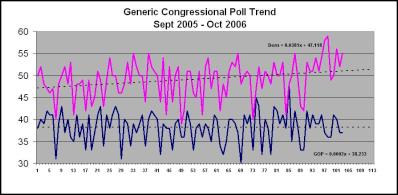
Click for big version
These charts display the positive slope of the Democratic trend vs. the flat GOP trend during the past 12 months across generic congressional polls. Chart 1 Chart 2
The House: A Monte Carlo Election Simulation Forecast
1000 simulated trial elections. Based on Polls as of Oct.14
Current House: 232 Republicans; 202 Democrats; 1 Independent
The Democrats need to capture 16 Republicans seats (net) to gain control of the House. How many of the 58-contested Republican House seats can the Democrats expect to win, assuming a fraud-free election?
Corollary: How many elections will the Republicans need “win” to maintain control?
In the most likely scenario the Democrats will win 60% of the undecided vote, they can expect to capture 32 of the 58 Republican-held seats. There is a 99% probability that they will win 30 or more. Therefore, the Republicans will have to steal a minimum of 16 elections in order to retain the House.
Of the 58 polls:1) Democrats lead in 15 races beyond the MoE
2) Democrats lead in 11 within the MoE
3) Democrats tie the Republicans in 5
4) Republicans lead in 15 within the MoE
5) Republicans lead in 12 beyond the MoE
The closest races within the margin of error are the ones most likely to be “ripe for stealing elections and for fraud,” as Rev. Soaries says, voter suppression, and those “coincidences” or machine malfunctions including vote switching.
They are the 22 districts between PA-6 and NY-29 in the chart: Chart
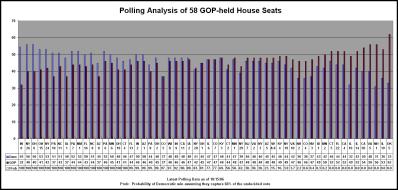
Click for big version
The analysis assumes nearly zero fraud and is based strictly on the latest poll shares, undecided voter allocation and margin of error. The model will be updated for new polling data and run again just prior to election day.
The simulation calculates the probability of the Democrats winning a specified number of the 58 seats, over a range of undecided voter allocation assumptions. It provides a very robust estimate of the minimum number of elections that would need to be stolen in order for the Republicans to retain control of the House.
In a published study of over 150 incumbent elections, the challenger won the undecided vote in 82% of the races, the incumbent won in 12%, and the rest were split.
Even with the very conservative UVA assumption that the undecided vote will be evenly split, then assuming the elections are fraud-free, it is a virtual 100% probability that the Democrats will net at least 25 Republican seats, or nine more than the minimum required for House control.
UVA:
Undecided voter % allocated to Democrats
N: number of
Republican seats won by Democrats
e.g. 25 seats gained at
50%> UVA
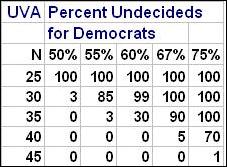
With a 60% UVA, the
Democrats can
See a pick up of 34 seats at 51%
probability.
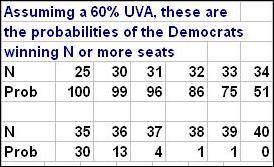
This chart displays the probability curve: click here.
US House of Representatives: 58 Races in Play
House Polling Detail. Races 1-10:
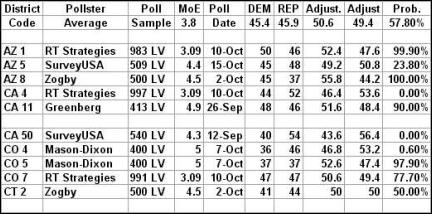
Full 58 House Races here. House Probabilities here. Democratic % here.
Races 48-58:
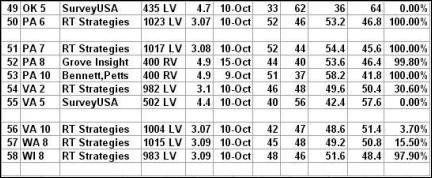
These are the districts with the highest probability of fraud, voter suppression, or “coincidental” equipment problems. The races are all within the margin of error and thus would raise less of a question should they result in one of those last minute comebacks to put the Republicans over the top.
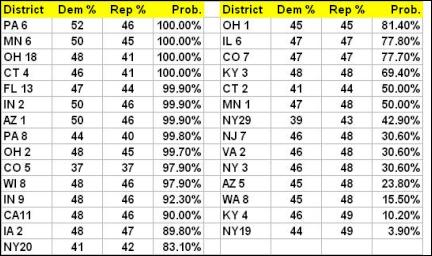
The Senate: A Monte Carlo Election Simulation Forecast
(1000 simulated trial
elections
Based on Polls as of Oct.14)
Current Senate: 55 Republicans; 44 Democrats; 1 Independent
There are nine critical races: New Jersey, Tennessee, Virginia, Missouri, Connecticut, Montana, Ohio, Pennsylvania, and Rhode Island
The Democrats need to hold their lead in New Jersey and win 6 of the other 8 seats for a 50-49-1 majority. They have solid leads in 5 GOP seats, a narrow lead in TENNESSEE, and are slightly behind in Virginia. Lieberman (Ind) is far ahead in CT. Assuming they win the 5 solid GOP seats and retain New Jersey seat, they need to win either Virginia or Tennessee for a majority.
Therefore, Virginia and Tennessee should be closely monitored for fraud or other irregularities.
Probability of Democratic Victories in the Senate.
Sensitivity Analysis: Assuming zero election fraud and that the Democrats capture 60% of the undecided vote (UVA), then with an election based on these polls, there is a 99% probability that they will win a 50-49 senate majority. The win probability is slightly lower (91%) if the undecided vote is split (50% UVA).
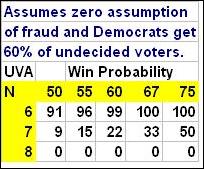
The analysis shows the relationship between undecided voter decisions at different splits between Democrats and Republicans in the Senate races. At a 50%-50% split with undecideds, the Democrats should pick up six seats right now. The hurdle to a larger pick up is significant given current polls. This can change quickly with adjusted poll data indicating a shift in public preferences.The difficult of getting above six seats reinforces the need for greater attention to signs of election fraud.
Those marked in yellow are the critical
races, and are top targets
for voter suppression and
election fraud problems.
PROB is the probability of a Democratic win (assuming a 60% UVA)
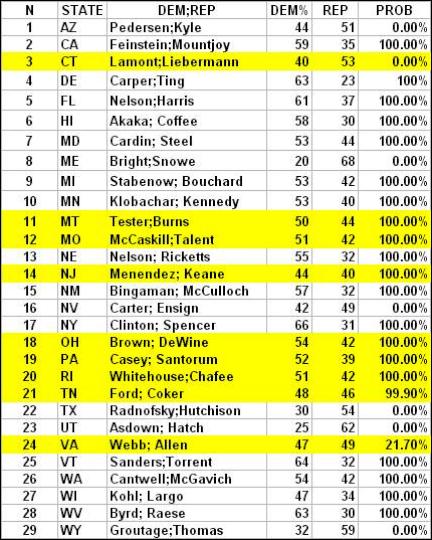
Unweighted Poll Average: Dem: 49.5%, Rep: 42.2%, Prob.: 74.3%
Full list of Senate Races here. Senate Races by Democratic % here.
These races are still fluid and shifts are common in the last two weeks of the campaign.
Based on the data, these are the races that will determine control of the US Senate. Unless the Democrats plan for a 1994 election shift, special attention is required. Of these states, Pennsylvania had numerous election irregularities in 2004; Ohio’s election was a disgrace; Missouri was the site of poll closing and other controversies; Tennessee experienced problems with electronic voting. In 2005 Virginia had a recount that didn’t allow counting optical scan ballots!
Note that the polls and associated probabilities do not factor in spoiled and lost votes (mostly democratic) which occur in every election. This suggests that the net Democratic lead may be 1% lower than the polls suggest. On the other hand, the undecided vote (currently 5%) usually splits in favor of the challenger - in this case, the Democrat. So we may have a wash here.
The calculations don’t factor in a sudden event, an “October” surprise, for example, that might shift more races into one of the three categories. Given the impact of the Foley scandal and the likelihood of more in that or another emerging from the scandal rich terrain of the Republican congress, this is a very real possibility.
In addition, ABC News, in part of a general press turn around to more coverage is actually raising the likelihood of what they call “bias” as a result of e-voting. “Bias” here is surely a code word for fraud since machines need human intervention be biased.
The Election Fraud BEAT DOWN
The beat down first showed up in Florida when Republicans unified and did everything they could to scare Democrats off and turn a loss into a stolen election. With the exception of Al Gore resisting, the balance of the Democratic leadership stood back and allowed the distortions, “preppy riots,” and outrageous Supreme Court decision to go unchallenged. Beat down refers to the strategies of voter suppression, voter disenfranchisement, and extreme “leveraging” of technology that seems to favor Republican candidates time after time.
Greg Palast outlined key strategies that have nothing to do with electronic voting. These are time honored techniques that have been honed to perfection over decades. The following four points are provided in Palast’s new article, Recipe for a Cooked Election in YES magazine:
Four Traditional Voter Suppression Strategies from
Greg Palast: No E-Voting RequiredProvisional Ballots Rejected. An entirely new species of ballot debuted nationwide in 2004: the "provisional ballot." These were crucial to the Bush victory. Not because Republicans won this "provisional" vote. They won by rejecting provisional ballots that were cast overwhelmingly in Democratic precincts. The sum of "the uncounted" is astonishing: 675,676 ballots lost in the counties reporting to the federal government. Add in the missing jurisdictions and the un-vote climbs to over a million: 1,090,729 provisional ballots tossed out. Spoiled Ballots. You vote, you assume it’s counted. Think again. Your "x" was too light for a machine to read. You didn’t punch the card hard enough and so you "hung your chad." Therefore, your vote didn’t count and, crucially, you’ll never know it. The federal Election Assistance Commission toted up nearly a million ballots cast but not counted. Add in states too shy to report to Washington, the total “spoilage” jumps to a rotten 1,389,231. Absentee Ballots Uncounted. The number of absentee ballots has quintupled in many states, with the number rejected on picayune technical grounds rising to over half a million (526,420) in 2004. In swing states, absentee ballot shredding was pandemic. Voters Barred from Voting. In this category we find a combination of incompetence and trickery that stops voters from pulling the lever in the first place. There’s the purge of "felon" voters that continues to eliminate thousands whose only crime is VWB — Voting While Black. It includes subtle games like eliminating polling stations in selected districts, creating impossible lines. No one can pretend to calculate a hard number for all votes lost this way any more than you can find every bullet fragment in a mutilated body. But it’s a safe bet that the numbers reach into the hundreds of thousands of voters locked out of the voting booth.
The inherent unreliability of electronic voting
Electronic voting is always in secret and controlled by private vendors. Two of the three major vendors are United States corporations with very serious Republican ties. The third is foreign with undetermined ownership. The GOP-friendly voting machines (and companies) have major security risks including vulnerability to hacking, malicious code, subtle pre programming. These apply to optical scan and touch screen voting machines. These security problems have been clearly demonstrated by world leading computer security expert Haari Hursti’s hacks of both touch screen and optical scan machines and the recent Princeton University study.
Electronic vote tampering leaves no evidence for a prosecution.
If the equipment can’t be monitored sufficiently to catch fraud, it becomes a menace to voter confidence and the ability to insure that those elected and serving were actually elected in the first place. The ElectionArcive.Org makes the following key points in a pdf on election problems that is vital for everyone concerned about free, fair and accessible elections (click on link to download the entire presentation, a must for activists).
National Election Data Archive
P.O. 682556 Park City, UT 84068Electronic Vote Tampering Leaves No
Evidence to prosecute with
- Machine code is not humanly readable
- Hundreds of programs on every machine
- Many months to reverse-engineer one voting machine
- Reverse engineering may find no evidence
- Network connections, hidden wireless cards or viruses in proprietary hardware & software can be used to undetectably shift just enough votes to change an election.
- © 2006 US Counts Votes
There should never be any need to review presentations like the outstanding resource provided by the ElectionArchive.Org, but there is one now. Given the ongoing voter suppression strategies in place for decades plus the new opportunities of elections through various means of digital exploitation, the time for vigilance is now. Everyone who is able should show up and vote. Everyone who is able should be involved with their elections demanding that they be run openly, fairly, and inclusively. Those who experience problems should report them. And those who are particularly motivated can contact these organizations who will provide outlets for the type of energy necessary to develop an election system that will allow us to say with certainty that we live in a real democracy. Free, fair, transparent, and inclusive elections will also allow those who assume office to actually prove that they have the right and mandate to do so through a legitimate election.
Partial list of groups working against voter suppression and election fraud:
- The NAACP - http://action.naacp.org
- Election Defense Alliance - http://www.electiondefensealliance.org/"
- League of Women Voters - http://www.lwv.org
- Velvet Revolution - http://www.velvetrevolution.us/
- Advancement Project - http://www.advancementproject.org/
©Copyright: Please feel free to reproduce
and distribute this in any fashion you feel suitable with an
attribution of authorship and the publisher, “Scoop”
Independent News, plus a link to the
article.


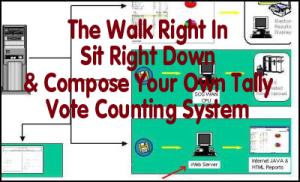
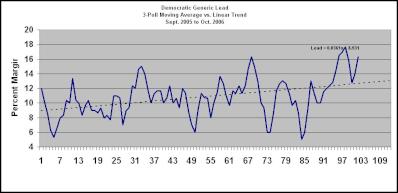
 Binoy Kampmark: Olfactive Implications - Perfume, Power And Emmanuel Macron
Binoy Kampmark: Olfactive Implications - Perfume, Power And Emmanuel Macron Martin LeFevre - Meditations: True Abundance
Martin LeFevre - Meditations: True Abundance Binoy Kampmark: Junk Science And Bad Policing - The Homicide Prediction Project
Binoy Kampmark: Junk Science And Bad Policing - The Homicide Prediction Project Keith Rankin: Rational Expectations, Intelligence, And War
Keith Rankin: Rational Expectations, Intelligence, And War Peter Dunne: Dunne's Weekly - Is Andrew Little Wellington's Mayor-In-Waiting?
Peter Dunne: Dunne's Weekly - Is Andrew Little Wellington's Mayor-In-Waiting? Gordon Campbell: On Peter Dutton’s Fading Election Prospects.
Gordon Campbell: On Peter Dutton’s Fading Election Prospects.